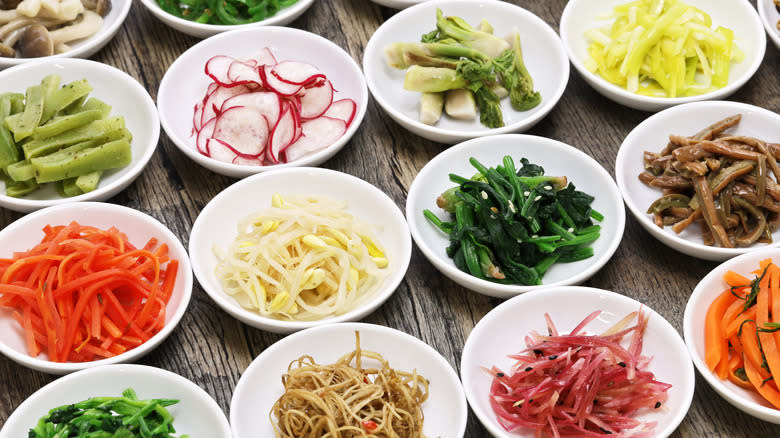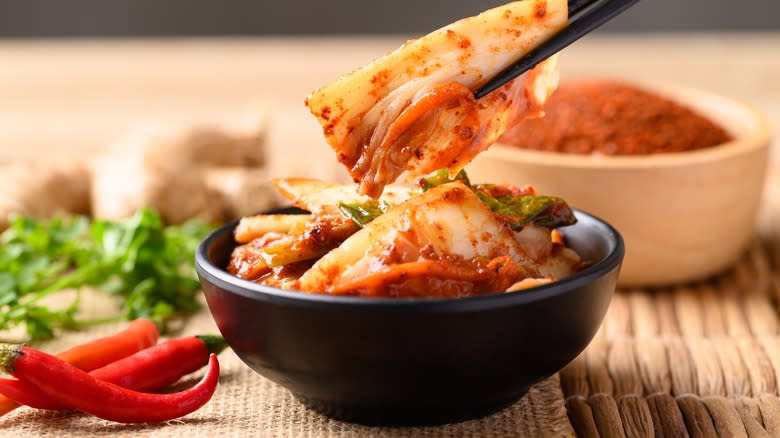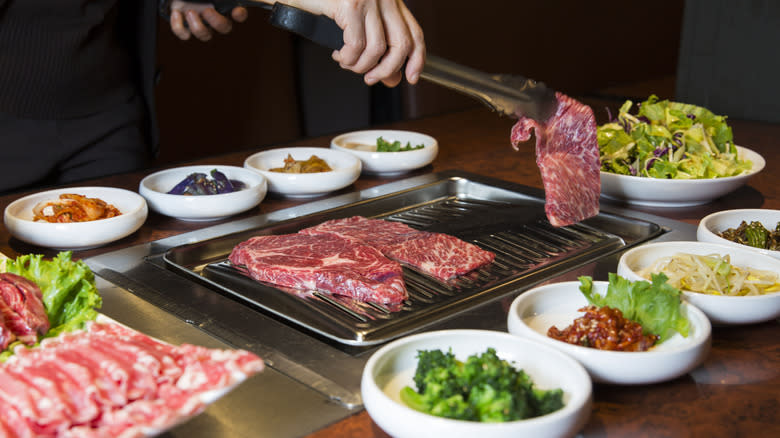The Banchan Tip That'll Improve Your Next Korean Restaurant Experience

Upon visiting a Korean BBQ restaurant, you may have noticed the wide selection of small side dishes that are served in addition to the main course. These dishes are known as banchan, and they're definitely not meant to be eaten as appetizers. Instead, banchan are best eaten with the main course, as the small dishes are chosen to pair with the flavors of the entree — sort of like substantial condiments to construct the perfect bite.
For that reason, diners should not fill up on banchan, no matter how tasty the dishes may be on their own. Speaking with VoyageLA, Los Angeles-based Korean chef Jihee Kim clarified the tradition of serving banchan, stating, "Banchan are all the little side dishes that normally complement any Korean meal." The chef went on to say there are no real limits as far as what goes into making banchan, although it's best for the dishes to be prepared with "fresh, seasonal ingredients." For that reason, you can expect any given banchan assortment to include a diverse confluence of tastes, colors, and textures.
Read more: 12 Vegetables And Fruits That Used To Look Very Different
Types Of Banchan Served At Korean Restaurants

One of the best-known banchan dishes is kimchi, which features a tangy, umami-forward flavor profile thanks to fermented vegetables. Different types of kimchi consist of various ingredient combinations, including cabbage, cucumbers, radishes, and many other veggies. As for flavoring agents, kimchi can be seasoned with fish sauce, chile flakes, garlic, ginger, sugar, and a variety of other boldly flavored ingredients, depending on the type of kimchi being enjoyed.
There's also jangajji, which features vegetables pickled in a mixture of soy sauce, sugar, and vinegar. Like kimchi, jangajji is made with all kinds of vegetables, including peppers, cucumbers, squash, onions, and perilla leaves, which is an herb that imparts a somewhat minty, licorice-like flavor. Other banchan include jeon, a type of savory pancake; sigeumchi namul, which is blanched spinach seasoned with garlic, soy sauce, and sesame oil; and gamja jorim, AKA Korean-style potato salad. Banchan selections typically star vegetables but also feature meat, seafood, and starches. They can vary greatly depending on the establishment and the main dish being served, so expect to see something new everywhere you go.
The Delicious History Of Banchan

While it's a proud Korean culinary tradition steeped in history, the origins of banchan are somewhat disputed. While some claim that the veggie-heavy practice arose from the Buddhist vegetarian beliefs influencing Korea between 60 BCE and 670 CE, others assert that it had more to do with a lack of resources throughout the country's history. Because meat was often in short supply, vegetable preparations were standard during mealtimes and were typically accompanied by rice.
A royal version of banchan, known as hanshik, was considered a kingly food during the Joseon Dynasty, which lasted until the early 20th century. Unlike the banchan that is known and loved today, hanshik lacked intensely spicy flavors. Additionally, hanshik consisted of 12 dishes, whereas the banchan served today usually come in groupings of 3, 5, or 7. While it may be difficult to pin down the exact history, there's no doubt that banchan have since spread beyond Korea and now captivate diners all over the world.
Read the original article on Daily Meal.

 Yahoo Finance
Yahoo Finance 